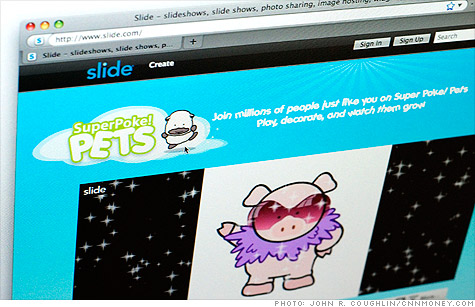CNN消息:从产品社交化趋势看google社交网络构建
最近,谷歌悄然地在社交网站游戏领域进行各种应对Facebook的准备,计划在其各种主打产品中融入“社交元素”。
在过去的几个月中,谷歌公司总计在社交网络行业进行了5次并购,分别收购了手机社交游戏公司SocialDeck,社交网站搜索应用Angstro,社交流行商店Like.com,社交游戏虚拟货币Jambool和社交游戏开发公司Slide。此外谷歌公司拥有社交游戏开发公司Zynga的大量股份。
针对谷歌的这一连串收购动作,Forrester Research的分析师Josh Bernoff并不认为谷歌真的会将这些收购组合在一起。Bernoff认为谷歌的最近几次收购的目的并不在于产品,而在于人才。通过收购,谷歌可以聘用到熟悉社交网络领域的工程师人才。
那么,这一切到底是为了什么呢?
保密了几个月后,上周谷歌在亚利桑那州举办的时代精神会议上公布了自己的计划。会议中,Schmidt表示谷歌并不会出产单独的社交网络产品,而是计划开发可以连接各种现有产品及网络应用的社交网络工具。
这一计划与谷歌过去的常规方式不同。Orkut和Buzz大型的社交产品并不卖座,而谷歌自己的协同工具Wave最近也暂缓发售。这比较类似于微软的一贯做法:开发一款又一款大型产品,然后寄希望于某个产品可以大受欢迎。
现在谷歌的新计划则更夸张——完全寄希望于本公司的坚强实力。
IDC的分析师Hilwa认为与其孤注一掷开发新产品与Facebook对抗,谷歌更倾向于发展其现有应用及产品的社交功能。
这也是现在包括Facebook在内许多公司共同寻求的一种策略。网络“社交”并不是一个目的,而是一种在网络上和别人一起分享、讨论各种事情的能力。
现在各种应用都融合了社交功能:Apple在iTunes上添加了“Ping”功能,社交网站Facebook则新增了“Like”按键。
这也是谷歌长久以来忽略的重要部分。据ComScore数据显示,今年7月谷歌网站总访问人数高达1亿7800万,是世界上流最高的网站,其月访问人数比社交网站Facebook多了3300多万人。
但据Compete Inc数据显示,自今年二月以来Facebook的门户网站流量却超越了谷歌。这一情况对于以销售广告为主要经营模式的谷歌十分不利。
现在,谷歌的一些产品如Gmail和YouTube已经内置了状态消息,即时通讯,评价和媒体分享等社交网站元素。但是这些并不包括google最核心的产品搜索。
在服务中建立广泛的社交网络功能有利于谷歌更好的分析用户的喜好,从而更好的进行目标广告。但首先谷歌必须坚持以“社交”为中心。这里有buzz滑铁卢的前车之鉴。
Bernoff认为,如果将来社交将充斥在网络的每一个角落,那么谷歌的最终目标就并不局限于开发单独一款产品或网站,而是要开发一款能将所有的谷歌产品联系在一起的社交设备。
Google has quietly been stocking up on tools it will need to challenge Facebook in the social networking game, and says it’s on the verge of launching a “social component” to a number of its core products.
Over the past month, Google (GOOG, Fortune 500) has made five acquisitions in the field: SocialDeck, a mobile social gaming company; Angstro, a social networking search application; Like.com, a social fashion store; Jambool, a social gaming virtual currency; and Slide, a social game maker. It also has a large stake in gaming giant Zynga.
But before you start to arrange the puzzle pieces, analysts say don’t bother.
“Trying to predict how Google will put everything together using acquisitions is a fool’s game,” said Josh Bernoff, analyst at Forrester Research. “It’s highly unlikely that the pieces will emerge into some form.”
Google has a habit of making acquisitions to buy up talent, not products. Bernoff believes many of the recent deals were done to pick the brains of the companies’ engineers, who have experience with social networks.
So what’s all this for?
After months of secrecy, Google finally began shedding light on its plans at last week’s Zeitgeist conference in Arizona. Schmidt told reporters that Google would not be coming out with one new social network product. Instead, it plans to will unveil social networking tools that will be woven throughout its existing products and Web applications.
It’s the opposite of what Google has done — and failed at — in the past. Big social products like Orkut and Buzz have largely flopped, and Google’s collaborative tool Wave was recently canned. It was the Microsoft approach: build big product after big product and hope that one eventually sticks.
Google’s new approach is more incremental — which plays to the company’s strengths.
“Rather than bang its head against the wall trying to create a competitor to Facebook, Google appears to have come to the realization that all of its applications and assets have social aspects that can be extruded,” said Al Hilwa, analyst for IDC. “It’s more of a mall than a department store approach.”
It’s a strategy that many companies — including Facebook — are starting to employ. “Social” on the Internet is not about a destination, but about the ability to discover, share and discuss content on the the Web with others.
Social features are popping up in all kinds of applications, with Apple (AAPL, Fortune 500) adding “Ping” to iTunes and news publishers integrating Facebook’s “Like” button throughout their sites.
It’s a crucial element that Google has been largely missing out on. With 178 million visitors to its sites in July, Google is the most-trafficked Web entity in the world and has 33 million more visitors per month than Facebook, according to comScore.
But Facebook has been outpacing Google in referrals to portal sites (directing people to other websites’ home pages) since February, according to Compete Inc. That’s troubling for Google, since its business model relies on selling ads that direct traffic.
Some Google products like Gmail and YouTube already incorporate elements of a social network, like status messages, instant messaging, commenting and media sharing. However, the social layer has eluded Google’s largest product, search — even though Google’s PageRank algorithm is at its heart a social tool, factoring user behavior like linking into its results.
Building richer social networking features into its offers could help Google better analyze users’ preferences, and better target ads to them. But first, it will need to wrap its head around the social mindset — something it’s struggled with so far. Exhibit A: Buzz’s troubled rollout. Stocking up on social media upstarts — and the creators who built them — could help Google fine-tune its approach.
“If you imagine a very likely future when social is a part of everything you do online, the end goal will not be to create a single product or site to capture that,” Bernoff said. “If Google can provide a social structure around its products, it’s much more likely to maintain its relevance.” (Source: CNNMoney.com)








































 闽公网安备35020302001549号
闽公网安备35020302001549号